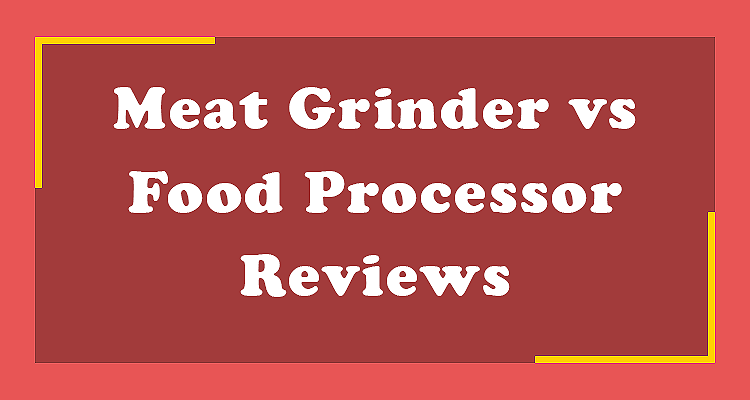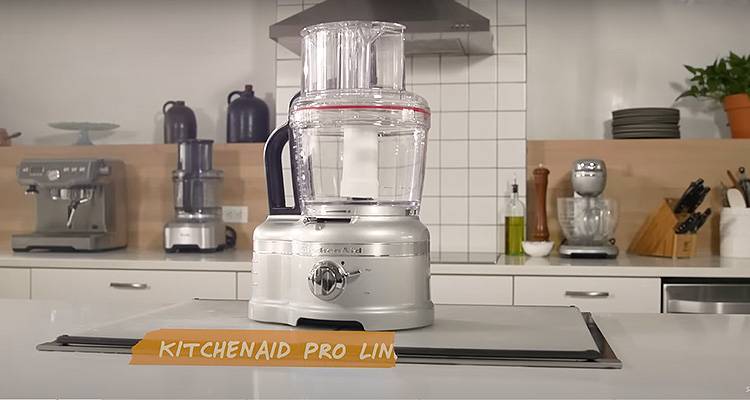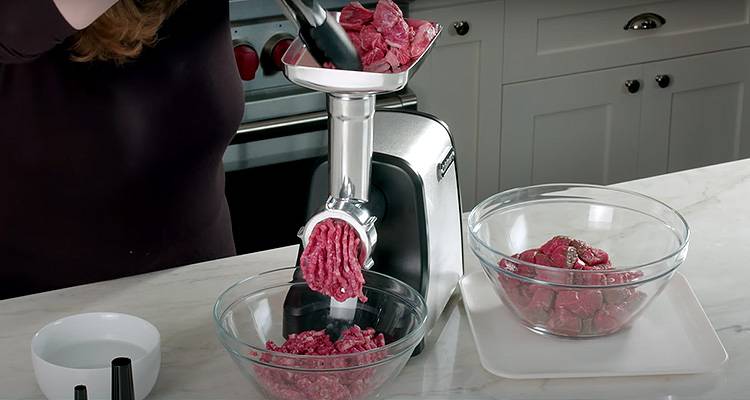
Introduction: Meat Grinder vs Food Processor
In the realm of culinary tools, the choice between a meat grinder and a food processor can be a puzzle. Both are versatile kitchen appliances, but each serves a unique purpose. The “Meat Grinder vs Food Processor” debate revolves around precision and Functionality.
Meat grinders are designed specifically for grinding and processing meat, making them indispensable for meat-based dishes, sausages, and more. On the other hand, food processors are culinary workhorses, excelling at chopping, pureeing, slicing, and dicing.
This article delves into the core distinctions between meat grinders and food processor, scrutinizing their features, performance, and applications. If you’re a passionate foodie or a home chef eager to broaden your culinary toolkit, our evaluation will guide you in making a knowledgeable choice. So, let’s embark on this culinary journey and find the perfect kitchen companion for your culinary adventures.
What is a Meat Grinder?
A meat grinder is a kitchen appliance designed for grinding, mincing, or chopping meat. It is a versatile tool used to process various types of meat, including beef, pork, chicken, or game meats. Various sizes of meat grinders are available, and they can be either manually operated with a hand crank or powered by electricity, offering a convenient and efficient method for creating ground meat to suit a range of culinary needs.
They are commonly used to make homemade sausages, burgers, meatballs, and other dishes that require finely ground or customized meat textures. Meat grinders are a valuable addition to kitchens, especially for those who prefer to have control over the quality and freshness of their meat products.
Meat Grinder Uses and Benefits
A meat grinder proves to be a versatile and indispensable kitchen appliance, offering numerous applications and benefits that elevate your culinary endeavors:
Custom Meat Blends: One of the primary uses of a meat grinder is to create custom meat blends. You can combine different cuts of meat to achieve the perfect ratio of fat to lean meat for burgers, sausages, and meatloaf.
Homemade Sausages: Meat grinders are essential for making homemade sausages. You can control the ingredients, flavors, and texture, resulting in unique and delicious sausage varieties.
Fresh Ground Meat: Grinding your meat ensures freshness and quality. Opting for a meat grinder empowers you to select your preferred cuts of meat, reducing the chances of consuming processed or pre-ground meat laden with additives and preservatives.
Safety and Hygiene: Grinding meat at home allows you to maintain strict hygiene standards. You have control over the cleanliness of the equipment and the meat source.
Cost-Efficiency: Buying whole cuts of meat and grinding them at home is often more cost-effective than purchasing pre-ground meat from the store.
Reduced Food Waste: You can use meat grinders to process leftover meat or trimmings, minimizing food waste.
Control Over Texture: Whether you prefer coarse or fine ground meat, a meat grinder lets you customize the texture to suit your recipes.
Versatility: Meat grinders are versatile kitchen tools capable of processing a wide range of meats, from beef and pork to chicken and even game meats. They are also handy for grinding other ingredients like vegetables or nuts.
Preserve Meat Quality: When you grind meat immediately before use, it preserves the natural flavors and juices, resulting in tastier dishes.
Let’s check it out: How to Work a Ninja Coffee Maker How to Clean Cuisinart Coffee Maker How to Use a Pressure Cooker Which Coffee Has the Most Caffeine Why Are Espresso Machines So Expensive
Types of Meat Grinders
Meat grinders come in various types, each with its unique features and applications. The main types of meat grinders include:
Manual Meat Grinders: These grinders are operated by hand, usually with a hand-crank mechanism. They are affordable, easy to use, and perfect for occasional use or smaller quantities of meat. Manual meat grinders are great for home cooks who don’t need to process large amounts of meat.
Electric Meat Grinders: Electric grinders are powered by electricity and offer more efficiency and speed. They come in various sizes, making them suitable for both home and commercial use. Electric meat grinders are ideal for processing larger quantities of meat quickly and with less effort.
Attachment Meat Grinders: Some kitchen stand mixers have attachment options for meat grinding. You can connect these attachments to your mixer, turning it into a meat grinder. They are convenient for those who already own a compatible mixer and want to save space in their kitchen.
Commercial Meat Grinders: These heavy-duty machines are designed for high-volume use in restaurants, butcheries, and food processing establishments. They are powerful, durable, and capable of grinding large quantities of meat efficiently.
Bolt-Down Meat Grinders: These are typically larger, manual meat grinders designed to be bolted or clamped onto a surface for stability during use. They are often used in commercial settings where consistent and large-scale meat grinding is necessary.
Patty Makers: While not technically meat grinders, patty makers are essential for shaping ground meat into uniform patties. They are commonly used in burger restaurants and home kitchens for making perfectly shaped burger patties.

What is a Food Processor?
A food processor is the indispensable workhorse of the modern kitchen. This versatile appliance simplifies food preparation by performing a range of tasks, from chopping and slicing to pureeing and kneading. With a motorized base and an array of attachments, it can transform ingredients into the desired textures with speed and precision. Food processors are invaluable to both home cooks and professional chefs, streamlining the cooking process and enabling the creation of diverse recipes. They save time, reduce manual labor, and open the door to culinary creativity, making them an essential tool for anyone passionate about cooking.
Food Processor Uses and Benefits
A food processor is a kitchen essential, offering a multitude of uses and benefits:
Time Saver: It speeds up food preparation by quickly chopping, slicing, and dicing ingredients, reducing manual labor.
Versatility: Food processors can handle a wide range of tasks, from shredding cheese to kneading dough.
Consistency: They ensure uniformity in ingredient sizes, which is essential for even cooking.
Efficiency: From pureeing soups to blending smoothies, they simplify various cooking processes.
Creative Cooking: Food processors encourage culinary experimentation, allowing home cooks to try new recipes.
Meal Prep: They are perfect for prepping ingredients in advance, saving time during busy weeknights.
Reduced Waste: Using a food processor can help make the most of ingredients and reduce food waste.
Healthy Eating: With ease, they enable the preparation of fresh, homemade dishes, promoting healthier eating.
Convenience: These appliances cater to both novice and experienced cooks, making complex tasks accessible to all.
In summary, a food processor is a versatile kitchen ally, simplifying meal preparation, enhancing cooking efficiency, and inspiring culinary creativity. It’s a valuable addition to any kitchen, offering a broad spectrum of uses and benefits.
Types of Food Processors
Food processors come in various types, each designed to cater to specific cooking needs and preferences. Here are some of the common types of food processors:
Mini Food Processors: Compact and portable, these are ideal for small kitchens or for those who need basic chopping, mincing, or pureeing tasks. They are perfect for preparing ingredients for small recipes.
Full-Size Food Processors: These are versatile workhorses suitable for most kitchen tasks, including slicing, dicing, chopping, blending, and more. They are a staple in many households due to their multifunctionality.
Multipurpose Food Processors: Some food processors come with additional attachments and functions, such as dough kneading, citrus juicing, and more. They provide a wider range of culinary options.
Blender-Food Processor Combos: These appliances combine the functions of a food processor and a blender, allowing you to switch between chopping and blending tasks in one machine.
Commercial Food Processors: These heavy-duty machines are designed for high-volume use in commercial kitchens, capable of handling large quantities of ingredients efficiently.
Hand-Crank Food Processors: These manual food processors are excellent for off-grid or outdoor cooking, requiring no electricity. They are often used in camping or areas with limited power access.
Specialized Food Processors: Some food processors are designed for specific tasks, such as meat grinding or making nut butter. They excel in their designated function.
Immersion Blenders with Food Processor Attachments: Some immersion blenders come with food processor attachments, allowing for versatile and compact food processing.
When choosing a food processor, consider the cooking you typically do, your available kitchen space, and the variety of tasks you want to perform. Each type of food processor offers distinct advantages, so your selection should align with your specific culinary needs.
The Differences Between a Meat Grinder and a Food Processor
Functionality: Unleashing the Magic in Your Kitchen
Ah, the heart of every kitchen Functionality! The word itself ignites a spark of excitement in our culinary souls. Selecting between a meat grinder and a food processor marks a pivotal culinary decision that can significantly elevate your kitchen capabilities.
Imagine yourself in your cozy kitchen haven, ready to embark on an epic gastronomic adventure. With a meat grinder or food processor at your side, you hold unlimited power. The power to create delectable dishes that will tantalize taste buds and evoke emotions.
Let’s first explore the meat grinder’s realm of possibilities. This mighty tool boasts its prowess for transforming raw cuts into mouthwatering sausages or perfectly ground beef for juicy burgers. Picture creating signature recipes handed down through generations as you skillfully combine spices with premium meats.
Now step into the enchanting world of food processors, versatile wizards capable of chopping, dicing, slicing, and even kneading dough! Excels at effortlessly whipping up creamy hummus dips or finely mincing herbs for aromatic sauces that seduce palates.
Whether you lean towards mastering traditional meat-based delicacies or are enticed by endless culinary experiments using fresh produce and diverse ingredients, there lies your answer within these realms.
So ponder no more; embrace Functionality as your guide on this extraordinary journey toward unlocking your true kitchen potential. Let curiosity lead you through uncharted territories where flavor reigns supreme and creativity knows no bounds…
Power and Speed
In the realm of kitchen food preparation, the critical factors of power and speed can significantly impact the efficiency and success of your culinary endeavors. The battle between a meat grinder and a food processor is no exception. Both appliances boast impressive features, but which one truly reigns supreme?
Let’s start with power. A meat grinder packs a punch with its robust motor designed specifically for grinding various types of meat effortlessly. From tender cuts to tough, sinewy pieces, nothing seems to stand in its way! On the other hand, a food processor dazzles us with its versatility as it effortlessly chops, slices, shreds, and purees almost anything you throw at it.
Now, let’s shift gears onto speed. A meat grinder takes pride in its ability to grind pounds of meat within minutes, perfect for those big family gatherings or when meal prepping for the week ahead. Meanwhile, a food processor zooms through ingredients like lightning bolts, offering quick results whenever time is of the essence.
But here’s where things get interesting: what if we told you there might not be an ultimate winner? Both these kitchen wonders have their unique strengths that cater to different needs. Whether you prioritize power or need lightning-fast speeds may depend on your specific culinary requirements.
So before you decide which appliance deserves prime real estate on your countertop, consider how much power and speed factor into your everyday kitchen adventures. After all, only you hold the key to unlocking culinary excellence!
Blades and Attachments
When it comes to kitchen appliances, the battle between meat grinders and food processors is fierce. Both offer a range of blades and attachments that can turn even the simplest ingredient into a culinary masterpiece.
Let’s start with the meat grinder. With its assortment of specialized attachments, this mighty machine allows you to transform tough cuts of meat into succulent ground beef or sausage. Its sharp grinding blades can effortlessly tackle any texture, while adjustable settings give you control over the coarseness of your grind. But don’t be fooled by its name.
These machines are not limited to meats alone! Certain models of meat grinders include supplementary attachments tailored for crafting fresh pasta or extruding fruit purees, making them versatile tools for preparing homemade delicacies, including baby food.
Next up is the versatile food processor, a true multitasker in the kitchen. Equipped with an array of interchangeable blades, this powerhouse can slice, dice, shred, chop, and blend almost anything you throw at it. Need finely chopped onions? No problem! Craving some creamy homemade hummus? The food processor has got your back! From kneading dough to whipping up silky smooth sauces or dressings, there’s hardly a task this appliance cannot handle.
Whether you decide on a meat grinder or a food processor ultimately boils down to your culinary needs and preferences. Consider what types of dishes you frequently prepare in your kitchen and how each appliance’s blades and attachments align with those requirements.
So, which one will reign supreme in your kitchen? It’s time for you to decide!

Which One is Right for Your Kitchen? Meat Grinder or Food Processor
The choice between a meat grinder and a food processor often boils down to your culinary needs. If you’re a meat enthusiast who enjoys crafting sausages or burgers, a meat grinder is your ally. It offers precision in grinding, making it the go-to for meat-related tasks.
On the other hand, a food processor’s versatility shines in diverse kitchen duties, from chopping to blending. For general cooking and a wide array of recipes, it’s the top pick.
So, assess your cooking style and decide which tool complements your kitchen best: Meat Grinder vs Food Processor.
Considerations Before Making a Decision
When facing the choice of a Meat Grinder vs Food Processor, several factors come into play. First, consider your kitchen priorities. Are you focused on meat-centric recipes, or do you seek an all-around kitchen companion?
Next, contemplate your available kitchen space, as meat grinders and food processors come in various sizes. Your budget and frequency of use also matter. Meat grinders are a specialty tool, while food processors cater to general cooking.
Ultimately, it boils down to your culinary ambitions and kitchen dynamics. Choose wisely, and your kitchen endeavors will thrive with the perfect culinary companion.
FAQ’s: Meat Grinder and Food Processor
While primarily designed for grinding meats efficiently and evenly, some high-quality electric meat grinders with appropriate attachments may also be capable of processing other foods like fish or vegetables.
The fineness of the ground meat depends on your preference. Meat grinders usually offer different settings, allowing you to control how coarse or fine you want the end product to be. This flexibility allows you to achieve various textures suitable for different recipes.
No. Food processors vary in terms of power (wattage), bowl capacity, speed settings, included accessories (such as slicing/shredding discs), durability, and brand reputation, among others. Consider your specific needs before purchasing one that suits you best. Easy-to-understand question:
A food processor would be more suitable since it offers multifunctionality beyond just grinding meats, enabling you to undertake various chopping tasks required in everyday cooking.
Final Thoughts: Meat Grinder or Food Processor
In the culinary world, the debate of Meat Grinder vs Food Processor often comes down to your culinary priorities. If you’re passionate about perfecting meat-based dishes and grinding with precision, a meat grinder is your go-to. Its specialized function excels in creating finely ground textures.
On the other hand, the food processor’s multifunctionality shines when you’re a home cook with a range of culinary interests. It simplifies various kitchen tasks beyond meat processing.
Hence, the decision ultimately hinges on your distinct culinary aspirations and the roles you envision these kitchen companions fulfilling throughout your gastronomic adventure.
Leave a Reply